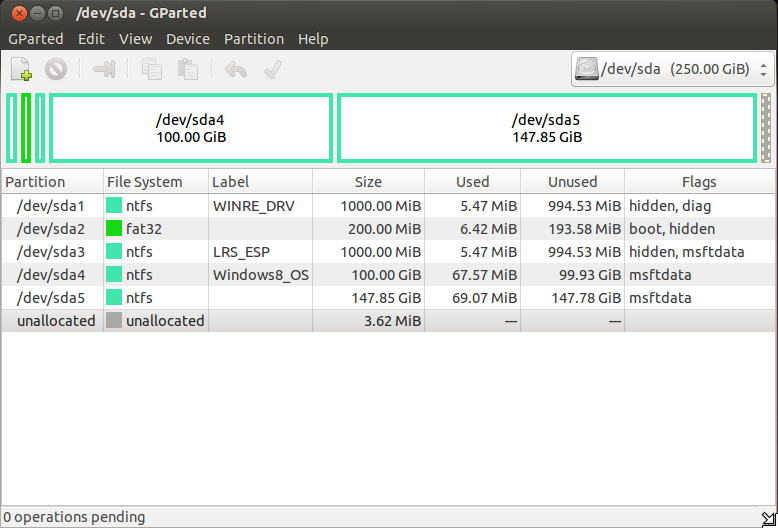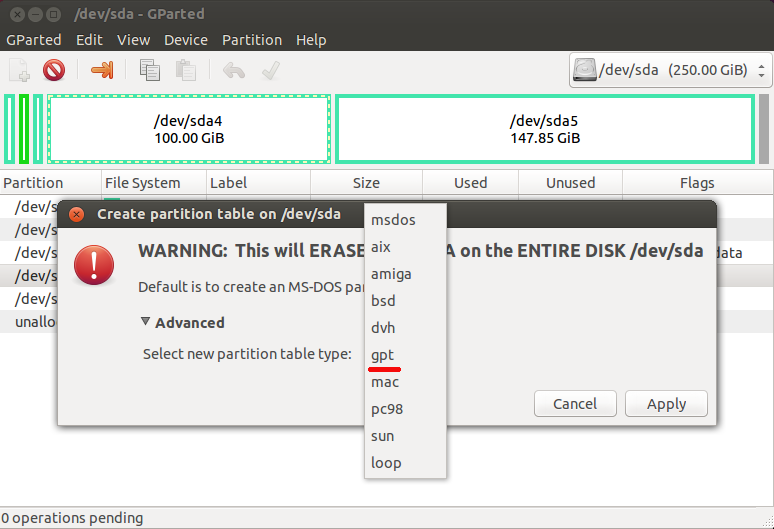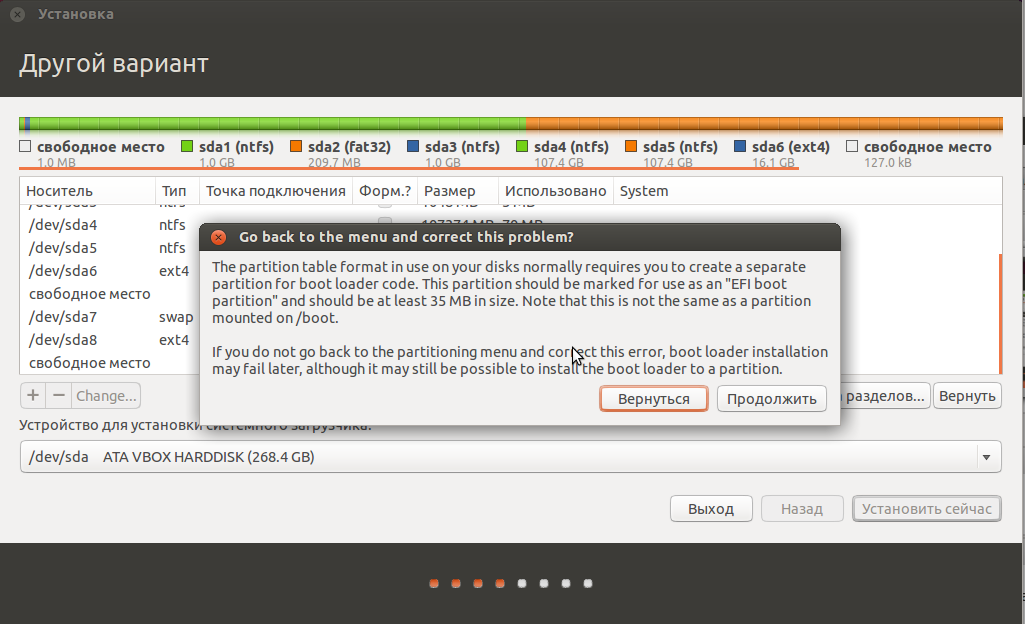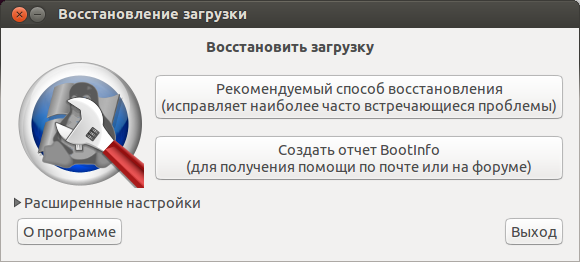Efi system partition что это ubuntu
Ubuntu Documentation
Note that these factors can conflict with one another. For instance, if you’re dual-booting with a pre-installed Windows 8 but have problems getting a UEFI version of GRUB to work, you’ll be in a bind. As a general rule, though, UEFI mode works better in dual-boot setups with pre-installed versions of Windows 8. If you’re installing Ubuntu as the sole OS on a computer, either mode is likely to work, although BIOS mode is less likely to cause problems.
Installing Ubuntu in UEFI mode
The following sections describe how to install Ubuntu in UEFI mode, either because you’re single-booting and want to try this boot mode or because you’re dual-booting with another OS that’s already installed in this mode.
Case when Ubuntu must be installed in UEFI mode
General principles
To install Ubuntu in UEFI mode:
Use a 64bit disk of Ubuntu. (Ubuntu32bit cannot be easily installed in UEFI mode. This is a problem if 32-bit UEFI is the only way your computer can boot, e.g. if you have a modern Intel Atom based laptop. In this case, you will need a complicated work-around.)
You might want to use an EFI-only image to avoid troubles with mistakenly booting the image and installing Ubuntu in BIOS mode.
Use a supported version of Ubuntu. Support for UEFI appeared in 11.10, but has become more reliable in next versions. Support for UEFI SecureBoot appeared in 12.10 and 12.04.2.
if you use the manual partitioning («Something else»), the difference is that you will have to set the /boot/efi mount point to the UEFI partition. And if there was not any UEFI partition on your HDD, you first will have to create it (see the «Creating an UEFI partition» paragraph below).
Identifying if the computer boots the HDD in UEFI mode
This is possible only if you have already installed Ubuntu on the HDD, or by looking at the BIOS setup (see paragraph below).
From an Ubuntu installed on the HDD (neither liveCD nor liveUSB), open a terminal (Ctrl+Alt+T), then type the following command:
Remark: if the result is «Legacy boot on HDD», then either the BIOS is not UEFI type, or the BIOS is not set up to boot the HDD in UEFI mode.
Identifying if the computer boots the Ubuntu DVD in UEFI mode
Warning: even if your PC boots the DVD in UEFI mode, it might boot the HDD in Legacy mode (and the contrary).
When booting on a 64-bit Ubuntu disk:
— If the BIOS is set up to boot the CD in UEFI mode, then you will see the screen below:
— If the BIOS is NOT set up to boot the CD in UEFI mode, or if the disk is not 64-bit, then you will see the screen below:
Set up the firmware in UEFI or BIOS/CSM/Legacy mode
Some recent computers (>2011) allow you to set up the computer to boot either in UEFI mode or in BIOS/CSM/Legacy (not-EFI) mode. The way to adjust this setting depends on the computers, but generally this setting is located in the «Boot order» tab of the BIOS (to access the BIOS screens, it is generally necessary to press a key during the PC startup). It can also often be set on a per-boot basis by hitting a function key (F8 and F10 are common choices) soon after you power on the computer.
Note: Some UEFIs (e.g. American Megatrends’ «Aptio», found on the Asus vivobook series) call Legacy mode «Compatibility Support Module» or simply «CSM».
Remark: Some UEFIs enable one to set up the boot mode for the optical drive separately from the boot mode for the HDD.
Here is a 2nd example of UEFI boot mode setting, where the «Boot Mode» parameter enables one to choose the boot mode («UEFI» or «Legacy») for all media (hard disk, CD, USB. ) at the same time.
Some other UEFIs propose an «UEFI/Legacy Boot:» option with the following choices: [Legacy only], [UEFI only] and [Both]. This last one boots in UEFI mode when possible, then in Legacy mode if no UEFI files are detected.
Creating an EFI System Partition
If you are manually partitioning your disk in the Ubuntu installer, you need to make sure you have an EFI System Partition (ESP) set up. This partition holds EFI-mode boot loaders and related files.
If your disk already contains an ESP (eg if your computer had Windows 8 preinstalled), it can be used for Ubuntu too. Do not format it. It is strongly recommended to have only 1 ESP per disk.
An ESP can be created via a recent version of GParted (the Gparted version included in the 12.04 disk is OK), and must have the following attributes:
Mount point: /boot/efi (remark: no need to set this mount point when using the manual partitioning, the Ubuntu installer will detect it automatically)
Size: minimum 100Mib. 200MiB recommended.
Performing the Installation
Once you’ve taken care of the preliminaries, you can install Ubuntu normally. Aside from the ESP, Ubuntu installed in UEFI mode has no special partition requirements, and you need not adjust other installation options. Note that in a UEFI-mode installation, Ubuntu will not ask you where to install the boot loader. If it does, or if it complains about the lack of a BIOS Boot Partition, you’ve probably accidentally booted in BIOS/CSM/legacy mode.
Identifying if an Ubuntu has been installed in UEFI mode
Installing Ubuntu for Single Boot with a Random Boot Mode
If you aren’t multi-booting with another OS and you don’t care about your boot mode, you can forego some of the picky details of the preceding procedure and install Ubuntu in whatever boot mode your computer happens to pick. This procedure is not recommended for multi-boot installations alongside existing UEFI-based OSes, because it can result in a combination of one OS installed in UEFI mode and the other in BIOS mode. Such setups will require post-installation repair or other awkward steps to manage switching OSes.
You should be able to get Ubuntu installed quickly using the following steps:
Create a LiveDVD or LiveUSB of Ubuntu (>=12.04.2) 64bit.
If the PC does not load Ubuntu, boot your PC using the Live CD/DVD or Live USB and choose «Try Ubuntu» once again. When the live session has loaded, run Boot-Repair (see link for details). When Boot-Repair loads, click on the «Recommended repair» button, and write on a paper the URL (paste.ubuntu.com/XXXXXX/) that will appear. Then reboot the computer. Do not run Boot-Repair unless you have problems booting the computer; the expression «if it ain’t broke, don’t fix it» applies to this tool.
This should fix most boot problems. If this does not fix your boot problems, please create a new thread in this forum, describing your problem and indicating the URL you wrote in the previous step.
Converting Ubuntu into UEFI or Legacy mode
Converting Ubuntu into UEFI mode
Note: Do not follow this procedure if your computer is already booting correctly. Use this procedure only if you believe you’ve accidentally installed Ubuntu in BIOS/CSM/legacy mode and you want it to boot in UEFI/UEFI mode.
Set up your BIOS so that it boots the HDD in UEFI mode (see the «»Set up the BIOS in UEFI or Legacy mode» paragraph above).
Converting Ubuntu into Legacy mode
Set up your BIOS so that it boots the HDD in Legacy mode (see the «»Set up the BIOS in UEFI or Legacy mode» paragraph above).
SecureBoot
«Secure Boot» is a new UEFI feature that appeared in 2012, with Windows8 preinstalled computers. All current Ubuntu 64bit (not 32bit) versions now support this feature, but as PCs implementing support for it have only become widespread at the end of 2012 it is not yet widely tested, so it’s possible that you may encounter problems booting Ubuntu under Secure Boot. If you do, please file a bug report against the shim package in Ubuntu, preferably using the command ubuntu-bug shim once you’ve installed with Secure Boot disabled.
Disabling SecureBoot in the BIOS
Here is an example of BIOS showing that «Secure Boot» is enabled:
To disable or enable Secure Boot, find a similar option in your BIOS, and use the keyboard to switch it to Enabled/Disabled.
Remark: if your PC has Windows8, you may need to follow the procedure below to access your BIOS.
Accessing the UEFI settings from Windows8
Go to the PowerOff options, and while holding the SHIFT key, click on Restart.
When the menu below appears, select Troubleshoot, then UEFI Firmware Settings.
The PC will reboot and you will be able to enter the BIOS (if not press the necessary key).
See also
— UEFIBooting (older documentation, maybe useful for Mac)
— Installing Ubuntu on a Pre-Installed UEFI Supported Windows 8 System: Step by Step guide to install Ubuntu on an UEFI/Secure Boot enabled computer that comes pre-installed with Windows 8
UEFI (последним исправлял пользователь rodsmith 2015-06-07 16:32:39)
The material on this wiki is available under a free license, see Copyright / License for details
You can contribute to this wiki, see Wiki Guide for details
Особенности установки на платы с UEFI
Итак, вы указали в настройках BIOS загрузку с CD/DVD или с USB, и при загрузке с Ubuntu LiveCD получили вместо фиолетового экрана с пиктограммами клавиатуры и человечка вот такой экран:
Введение в UEFI и GPT
Вы, наверное, помните, что одна из задач этого руководства — научить читателя эффективно и непринуждённо использовать все основные инструменты системы. Но для этого нужно копнуть глубже и рассказать об аппаратной начинке вашего компьютера, и как эта начинка работает с системой. Поэтому опять теория, без неё не обойтись.
Что происходит при включении компьютера? Прежде всего компьютер должен корректно инициализировать сам себя, то есть своё собственное оборудование, и передать управление загрузчику операционной системы. Занимается этим процессом «Extensible Firmware Interface» (EFI) (Расширяемый интерфейс прошивки) — интерфейс между операционной системой и микропрограммами, управляющими низкоуровневыми функциями оборудования. Раньше за это отвечал BIOS, а теперь EFI, который после очередного изменения стандарта стал называться «Unified Extensible Firmware Interface» (UEFI) — это название и будет использоваться в дальнейшем. Надо заметить, что UEFI, как более современный интерфейс, полностью поддерживает все функции BIOS, обратное, к сожалению, не верно. В настройках режим поддержки BIOS чаще всего называется «Legacy» («наследуемый» или «традиционный» по-английски) или просто «UEFI Disabled» («UEFI отключён», как не трудно догадаться). Сейчас, однако, нас интересует включённый режим UEFI.
Итак, при включении компьютера UEFI начинает инициализировать оборудование и находит какое-то блочное устройство, скажем, жёсткий диск. Вы, наверное, знаете, что целиком жёсткий диск практически никогда не используется — диск обязательно разбивается на разделы, в том числе и для удобства в обращении. А вот разбить его на разделы можно, на сегодняшний день, двумя стандартными способами: с помощью MBR или GPT. В чём их отличие?
А в случае UEFI всё происходит несколько иначе. Дело в том, что UEFI имеет собственный загрузчик операционных систем с интегрированными менеджерами запуска установленных ОС. С этой целью для него — для загрузчика UEFI — на диске должен быть создан небольшой раздел (100–250 МБ), который называется «Extensible Firmware Interface System Partition» (системный раздел расширяемого интерфейса прошивки, ESP). Кроме указанного размера, раздел должен быть отформатирован в файловой системе FAT32 6) и быть загрузочным. На нем находятся драйверы аппаратных компонентов, к которым может получать доступ запущенная операционная система. И в этом случае загрузка происходит прямо с этого раздела, что намного быстрее.
Разметка диска
Самое главное, у вас должен быть план ваших действий, поверьте — перечень шагов и порядок их выполнения достаточно обширен, так что желательно записать где-нибудь на бумажке основные пункты плана и периодически с ними сверяться. Итак, что же вам известно. Для нормальной установки Ubuntu в режиме UEFI жёсткий диск вашего компьютера должен быть правильно подготовлен, а именно:
Кроме того, нужно определиться с операционными системами на вашем компьютере — от того, будет ли Ubuntu единственной системой, или рядом с ней будут находиться другие поддерживающие режим UEFI системы, зависит план разбивки и установки.
Начнём с ответа на второй вопрос: о наличии других операционных систем. Если на вашем компьютере уже установлены операционные системы, поддерживающие загрузку в режиме UEFI (например, Windows 8), и вы не намерены пока от них отказываться, то первые два пункта плана уже выполнены: раздел ESP наверняка уже есть, ну и диск, разумеется, с GPT. Давайте проверим, что это действительно так.
Предположим, после запуска редактора разделов GParted у вас откроется вот такое окно 9) :
Итак, первые два пункта плана уже выполнены, а реализация третьего пункта: создание разделов для Ubuntu — достаточно подробно описана в примере использования GParted для переразбивки жёсткого диска. Напомним вкратце, что от диска с данными (в примере это /dev/sda5, или диск D: в Windows) нужно «отрезать» достаточное пространство и на его месте создать три раздела: подкачки, системный и раздел для домашнего каталога. Учтите также, что ваш диск — GPT, так что расширенного раздела, содержащего логические диски, у него нет, следовательно, при создании разделов выбирайте Primary partition («Основной раздел»).
В итоге должно получиться что-то похожее на эту картинку:
Здесь показаны дополнительно созданные разделы:
Эта информация очень пригодится в дальнейшем при установке Ubuntu, поскольку из-за большого количества разделов можно очень легко запутаться и назначить не той «цифре» требуемую точку монтирования.
А что делать, если ОН 11) уже наступил вы решили отказаться от использования других операционных систем и хотите установить Ubuntu единственной системой?
Тем не менее, продолжаем работать с редактором GParted. Ваша задача — удалить все разделы и на свободном месте создать нужную для Ubuntu конфигурацию диска. Для этого можно щёлкнуть правой кнопкой мыши на каждом из разделов и выбрать из выпадающего меню пункт «Delete». Но лучше поступить по-другому: найдите на панели меню редактора GParted пункт «Device» (Устройство) и выберите в меню «Create Partition Table…» (Создать таблицу разделов…). Появится предупреждение:
(ВНИМАНИЕ: это приведёт к УДАЛЕНИЮ ВСЕХ ДАННЫХ на ВСЁМ ДИСКЕ /dev/sda)
Не переживайте, вы же позаботились о резервных копиях? Посмотрите чуть ниже — на надпись «Advanced» (Подробности). Щёлкните мышью на треугольник слева и в меню выберите gpt :
Таким же образом создайте разделы под будущие: системный (15 ГБ с файловой системой ext4 ), раздел подкачки (4 ГБ с linux-swap ) и для домашнего каталога (всё оставшееся пространство в ext4 ). Как вы помните, GParted применяет изменения не сразу, а просто ставит их в очередь на выполнение. Поэтому нажмите на зелёную галочку «Apply All Operations» (Выполнить все операции):
Да, совсем не обязательно управлять флагами загрузки на этом этапе — установщик Ubuntu выполнит всё так, как надо. А теперь внимательно читайте про то, как устанавливать Ubuntu, и, как будете готовы, продолжим.
Установка Ubuntu
После такой подготовительной работы установка Ubuntu не вызовет трудностей, особенно если вы внимательно прочитали правила установки. Просто достаньте бумажку с перечнем разделов и обратите внимание, что для специального раздела EFI (/dev/sda2 из примера о совместной установки Ubuntu и Windows) нужно точно назначить свойство загрузочного раздела EFI, а не резервной загрузочной области BIOS:
Если вы этого не сделаете, то установщик покажет вам такое уведомление:
Исправьте ошибку, а если не получится, выйдите из установщика, запустите редактор GParted и проверьте, что всё, рассказанное выше, выполнено.
Назначения для всех остальных разделов, требуемых при установке Ubuntu, очень детально описаны в этом разделе, поэтому нет особого смысла останавливаться на этом подробней.
Возможные проблемы
Эта небольшая программа — очень мощный инструмент, позволяющий исправить практически все ошибки, которые могут возникнуть при загрузке Ubuntu и других операционных систем после установки.

Загрузите открытый ключ репозитория с программой из хранилища доверенных ключей 19) :
Обновите список приложений командой:
Установите и запустите Boot-Repair :
После непродолжительного сканирования появится основное окно Boot-Repair :

Как создать системный раздел EFI?
TL; DR Как создать системный раздел EFI с нуля? Как я могу поместить прошивку EFI на нее, она создана?
Длинная версия
В приведенном выше руководстве говорится:
Создание раздела EFI
Если вы вручную разбиваете диск на диск в установщике Ubuntu вам нужно убедиться, что у вас есть EFI настройка раздела.
Если ваш диск уже содержит раздел EFI (например, если ваш компьютер был предустановлен Windows8), он также может использоваться для Ubuntu. Не отформатируйте его. Настоятельно рекомендуется иметь только один раздел EFI на каждый диск.
Раздел EFI может быть создан с помощью последней версии GParted (версия Gparted, включенная в диск 12.04, в порядке), и она должна иметь следующие атрибуты:
Точка монтирования: /boot /efi (примечание: нет необходимости устанавливать эту точку монтирования, когда используя ручное разделение, установщик Ubuntu обнаружит его автоматически)
Размер: минимум 100Mib. Рекомендуется 200MiB.
Другое: требуется флаг загрузки.
У меня возникли проблемы с созданием этого раздела:
Однако у меня все еще есть эта проблема, и я полагаю, что это потому, что на этом разделе нет прошивки EFI, это всего лишь пустой раздел, подходящий для прошивки EFI.
Итак, как мне создать раздел EFI с программным обеспечением EFI, чтобы ноутбук мог снова загрузиться в режиме UEFI?
РЕШЕНИЕ Благодарим вас обоих за ответы. То, что я сделал, это установить Windows 8.1 с нуля, форматируя весь диск, а затем установив (на этот раз правильно) Ubuntu рядом с ним. Это мои разделы:
Во время установки Win 8, как только я удалил все существующие разделы и Windows переформатировал диск, он автоматически создал, помимо основного раздела установки, три дополнительных раздела, а именно 1, 2, 3. Теперь, после того, как я правильный ESP, я мог бы загрузиться с HDD или DVD в режиме UEFI.
Вы говорите, что ESP не сохраняет информацию по умолчанию, но я предполагаю, что когда ОС устанавливается, она помещает некоторую информацию там. Поэтому я предполагаю, что мое дело было следующим: я уничтожил его, и хотя я его воссоздал, он не был заполнен информацией, поскольку создание ESP было выполнено после установки ОС. Я потерял установку Ubuntu (неважно, это была новая установка в любом случае), но я предполагаю, что для ее сохранения я должен был следовать %20%D0%B3%D1%80%D0%B0%D0%BC%D0%BE%D1%82%D0%BD%D0%BE%D1%81%D1%82%D1%8C%20.%20%D0%9E%D0%B4%D0%BD%D0%B0%D0%BA%D0%BE%20%D0%BD%D0%B5%20%D0%B1%D1%8B%D0%BB%D0%BE%20%D0%B2%D1%80%D0%B5%D0%BC%D0%B5%D0%BD%D0%B8,%20%D0%BD%D0%BE,%20%D0%BA%20%D1%81%D1%87%D0%B0%D1%81%D1%82%D1%8C%D1%8E,%20%D1%82%D0%B5%D0%BF%D0%B5%D1%80%D1%8C%20%D0%B2%D1%81%D0%B5%20%D0%B2%20%D0%BF%D0%BE%D1%80%D1%8F%D0%B4%D0%BA%D0%B5.%20
EFI system partition
The EFI system partition (also called ESP) is an OS independent partition that acts as the storage place for the EFI bootloaders, applications and drivers to be launched by the UEFI firmware. It is mandatory for UEFI boot.
Contents
Check for an existing partition
If you are installing Arch Linux on an UEFI-capable computer with an installed operating system, like Windows 10 for example, it is very likely that you already have an EFI system partition.
To find out the disk partition scheme and the system partition, use fdisk as root on the disk you want to boot from:
The command returns:
If you found an existing EFI system partition, simply proceed to #Mount the partition. If you did not find one, you will need to create it, proceed to #Create the partition.
Create the partition
The following two sections show how to create an EFI system partition (ESP).
The partition size should provide adequate space for storing boot loaders and other files required for booting.
To prevent interoperability issues with other operating systems[1][2] it is recommend to make it at least 300 MiB. For early and/or buggy UEFI implementations the size of at least 512 MiB might be needed.[3] If none of these are relevant issues, the partition size can be as small as 2 MiB, in which case in could house nothing more than a boot loader.
GPT partitioned disks
Choose one of the following methods to create an ESP for a GPT partitioned disk:
After creating the partition, it should be formatted with a file system. Proceed to the #Format the partition section below.
MBR partitioned disks
See also Partitioning#Choosing between GPT and MBR for the advantages of GPT in general.
Choose one of the following methods to create an ESP for a MBR partitioned disk:
After creating the partition, it should be formatted with a file system. Proceed to the #Format the partition section below.
Format the partition
The UEFI specification mandates support for the FAT12, FAT16, and FAT32 file systems (see UEFI specification version 2.9, section 13.3.1.1), but any conformant vendor can optionally add support for additional file systems; for example, the firmware in Apple Macs supports the HFS+ file system.
To prevent potential issues with other operating systems and since the UEFI specification says that UEFI «encompasses the use of FAT32 for a system partition, and FAT12 or FAT16 for removable media»[4], it is recommended to use FAT32. Use the mkfs.fat(8) utility from dosfstools :
For partitions smaller than 32 MiB using FAT32 may not be possible. In which case, format it to FAT16 or even FAT12. For example, a 2 MiB ESP will only be able to support FAT12:
Mount the partition
The kernels, initramfs files, and, in most cases, the processor’s microcode, need to be accessible by the boot loader or UEFI itself to successfully boot the system. Thus if you want to keep the setup simple, your boot loader choice limits the available mount points for EFI system partition.
Typical mount points
The simplest scenarios for mounting EFI system partition are:
Alternative mount points
If you do not use one of the simple methods from #Typical mount points, you will need to copy your boot files to ESP (referred to hereafter as esp ).
Furthermore, you will need to keep the files on the ESP up-to-date with later kernel updates. Failure to do so could result in an unbootable system. The following sections discuss several mechanisms for automating it.
Using bind mount
After verifying success, edit your Fstab to make the changes persistent:
Using systemd
Using filesystem events
Filesystem events can be used to run a script syncing the EFISTUB Kernel after kernel updates. An example with incron follows.
Using mkinitcpio hook
Using mkinitcpio preset
As the presets in /etc/mkinitcpio.d/ support shell scripting, the kernel and initramfs can be copied by just editing the presets.
Replacing the above mkinitcpio hook
Edit the file /etc/mkinitcpio.d/linux.preset :
To test that, just run:
Another example
Using pacman hook
A last option relies on the pacman hooks that are run at the end of the transaction.
The first file is a hook that monitors the relevant files, and it is run if they were modified in the former transaction.
The second file is the script itself. Create the file and make it executable:
Troubleshooting
ESP on software RAID1
It is possible to make the ESP part of a RAID1 array, but doing so brings the risk of data corruption, and further considerations need to be taken when creating the ESP. See [7] and [8] for details and UEFI booting and RAID1 for an in-depth guide with a solution.


















